Mastering the Art of Plastic: The Intricacies of Injection Molding
Plastic injection molding is a versatile manufacturing process that has transformed the production of a wide range of plastic products. This technique involves injecting molten plastic material into a mold cavity, where it cools and solidifies to create the desired shape. The process is widely used in industries such as automotive, consumer goods, medical devices, and more, thanks to its efficiency and ability to produce complex and precise parts consistently. By understanding the intricacies of plastic injection molding, manufacturers can achieve high-quality products with cost-effective production methods.
Importance of Precision
Precision is the cornerstone of plastic injection molding. It is a meticulous process that demands exact measurements and calculations at every stage. The ability to achieve precise results ensures the production of high-quality plastic components that meet design specifications with unparalleled accuracy.
In plastic injection molding, precision plays a critical role in determining the final outcome of the manufactured parts. The precise control of temperature, pressure, and timing is essential to guarantee uniformity and consistency in the molding process. Any deviation from the specified parameters can lead to defects or variations in the final products.
Furthermore, mastering precision in plastic injection molding opens the door to limitless possibilities in design and functionality. By meticulously controlling every aspect of the molding process, manufacturers can create intricate shapes, intricate details, and complex structures that were once thought impossible. This level of precision is what sets apart ordinary plastic components from truly exceptional ones.
Key Steps in Injection Molding
Firstly, plastic pellets are heated in the injection molding machine until they reach a molten state. This process involves precise temperature control to ensure the material is at the optimal viscosity for molding.
Next, the molten plastic is injected into a mold cavity under high pressure. The mold is typically created in two halves, with one side attached to a stationary platen and the other to a movable platen. When the molten plastic fills the cavity, it takes the shape of the desired part.
Finally, the mold is cooled to allow the plastic to solidify. Once cooled, the mold opens, and the finished part is ejected. This cooling phase is critical to ensure the part retains its shape and properties.
Innovations and Future Trends
In the fast-paced world of plastic injection molding, constant innovation is key to staying competitive. quick turn injection molding are driving the industry towards greater precision, efficiency, and sustainability. Companies are investing in state-of-the-art machinery that enables them to produce complex components with high accuracy and speed.
One exciting future trend in plastic injection molding is the integration of artificial intelligence and machine learning. These technologies have the potential to revolutionize the manufacturing process by optimizing production parameters in real-time, reducing defects, and minimizing material waste. By harnessing the power of AI, manufacturers can achieve new levels of efficiency and cost-effectiveness.
Another area of focus for the future of plastic injection molding is environmental sustainability. With growing concerns about plastic waste and its impact on the planet, the industry is shifting towards greener practices. From using biodegradable materials to implementing energy-efficient processes, manufacturers are exploring ways to reduce their environmental footprint while meeting the demands of their customers.
